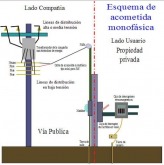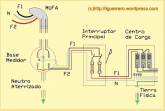mrdavvv
Solar Enthusiast
- Joined
- Jan 14, 2020
- Messages
- 404
Hello!.
This is my current system:

So im wondering, is this OK?.
As you can see, i have 3 physical grounds, all of them separated.
Ground 1: Exclusive to the PV panels, and not connected to any equipment, just the aluminum racks for panels.
Ground 2: This is required from Utility company, and must be bonded with the neutral cable behind the meter.
Ground 3: I plan to add this grounding to the main panel, and it would be only used for the house loads. Currently i dont have any type of ground inside the house, as the originall installes didnt consider it important.... ideally i would brin ground #2 to the main panel, but the existing installation doesnt allow for more cables, so i would need to open the wall (Big PITA). I could also send the cable outside the wall but as its an AWG #8 it would look ugly. Somy plan its to add a new ground near the main panel (Ground #3).
Mainly because its difficult to bring Ground #2 inside the house to the main panel, as the original instalation didnt have any type of ground
- All grounds are separated by at least 5mt between them.
- Grounds are made from a 2.5mt copper bar with #8AWG.
----
So what do you think about this installation?, im doing something wrong?.
-- I know i should be asking some professional, but the Solar guys say something, and the electricians other, dont know who to trust, so im triying to learn by myself to be sure i have a propper and safe installation..
Annex:
My country is using same earth configuration as USA (i think?) (TN-C-S)

This is my current system:

So im wondering, is this OK?.
As you can see, i have 3 physical grounds, all of them separated.
Ground 1: Exclusive to the PV panels, and not connected to any equipment, just the aluminum racks for panels.
Ground 2: This is required from Utility company, and must be bonded with the neutral cable behind the meter.
Ground 3: I plan to add this grounding to the main panel, and it would be only used for the house loads. Currently i dont have any type of ground inside the house, as the originall installes didnt consider it important.... ideally i would brin ground #2 to the main panel, but the existing installation doesnt allow for more cables, so i would need to open the wall (Big PITA). I could also send the cable outside the wall but as its an AWG #8 it would look ugly. Somy plan its to add a new ground near the main panel (Ground #3).
Mainly because its difficult to bring Ground #2 inside the house to the main panel, as the original instalation didnt have any type of ground
- All grounds are separated by at least 5mt between them.
- Grounds are made from a 2.5mt copper bar with #8AWG.
----
So what do you think about this installation?, im doing something wrong?.
-- I know i should be asking some professional, but the Solar guys say something, and the electricians other, dont know who to trust, so im triying to learn by myself to be sure i have a propper and safe installation..
Annex:
My country is using same earth configuration as USA (i think?) (TN-C-S)







